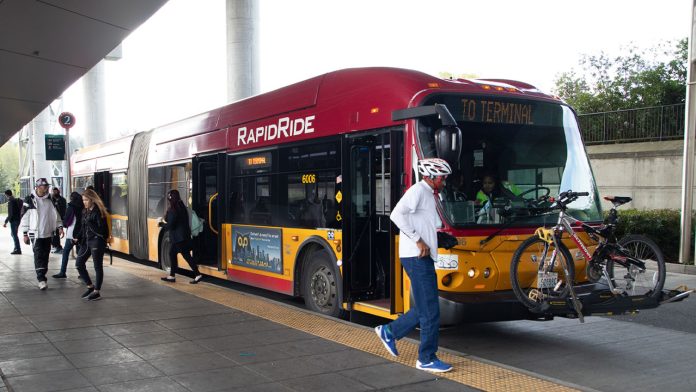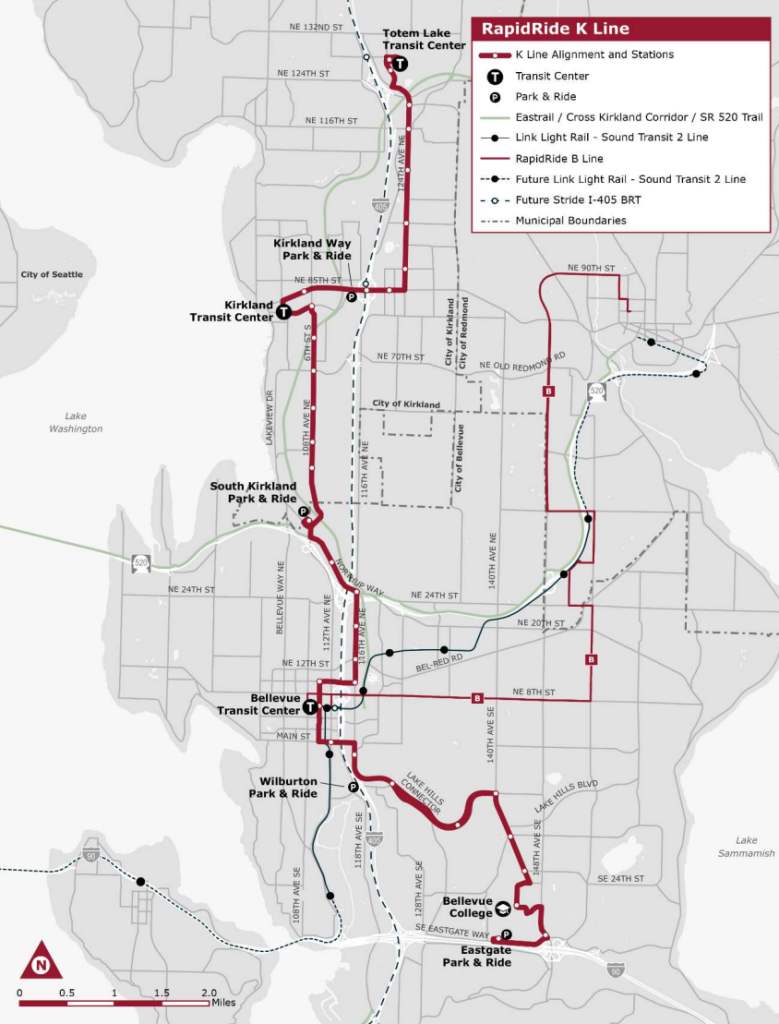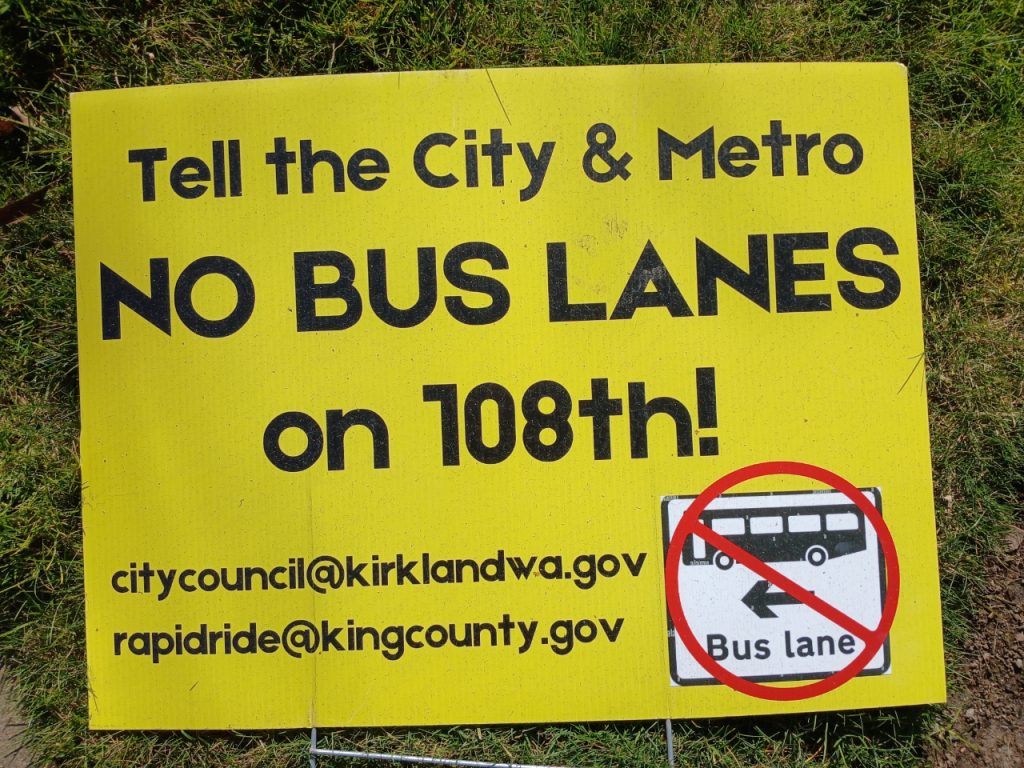
Both the Kirkland and Bellevue City Councils have officially given their stamp of approval to preliminary plans for a future RapidRide K line between Totem Lake and Eastgate. Planned for a 2030 grand opening, King County Metro is currently consolidating support behind a locally preferred alternative (LPA) in the hopes of getting in the queue for federal funding, even in the face of unprecedented uncertainty about the future of federal support for public transit.
The LPA lays out not only the route for the $105 million project, which upgrades portions of the existing routes 239, 250, 255 and 271 into a brand new transit corridor, but the improvements necessary to allow Metro to meet its goals of improving existing travel times by 15% to 30%. It also outlines ancillary projects that the K Line will also deliver in order to increase access to transit, including improved bicycle and pedestrian infrastructure, along with details on where stations will be upgraded.
This week the Bellevue City Council unanimously voted to send a letter supporting the K Line LPA, after another unanimous vote of the Kirkland Council last week. Those twin votes cap off months of discussions about the extent of transit improvements along the future K Line, which will be the first RapidRide line to open on the Eastside since the B Line between Bellevue and Redmond in 2011.

Once it’s open, the K Line will fill in a glaring gap in the county’s future transit network, connecting the future NE 85th Street Stride bus rapid transit station in Kirkland and Bellevue’s 2 Line stations with high-demand destinations including Totem Lake, Downtown Kirkland, and Bellevue College. By creating dedicated space for buses, adding transit signal priority, and consolidating stations, Metro expects the K Line to decrease the amount of time a transit rider would spend getting from one end of the route to the other during rush hour by more than 45 minutes, around 25%.
Transit lanes dropped on Bellevue’s NE 10th Street
The question of where the K Line will travel through downtown Bellevue has been a major focus of K Line work up to this point, along with the related question of where buses will get their own dedicated right-of-way through the area. Bellevue has been incredibly reluctant to give up general purpose vehicle capacity downtown, as shown through the Bike Bellevue saga, while at the same time city leaders have been vocally supportive of efforts to improve transit in downtown.
The corridor Metro eventually landed on through Downtown Bellevue is 110th Avenue NE. Respondents to a public survey preferred that route, likely due to its direct connection to the Downtown Bellevue light rail station, which is next door to Bellevue City Hall.
The LPA the council endorsed this week includes business access and transit (BAT) lanes along Main Street and 110th Avenue NE downtown, and along 116th Avenue NE in Wilburton. All told, these upgrades are set to save riders 10 minutes on every trip made during the afternoon peak when the K Line opens, but one additional upgrade that would help riders was dropped.

A westbound BAT lane across I-405 along NE 10th Street was studied by Metro, but City of Bellevue put the project in its crosshairs. After a few councilmembers raised questions in February about how a BAT lane there would impact traffic, analysis completed by the city subsequently revealed that there would be detrimental impacts on other drivers on NE 10th Street… in 2044.
Bellevue’s modelling showed that drivers would divert to NE 8th Street and NE 12th Street, causing some traffic backups, and that removing the BAT lane “fully mitigates anticipated diversions.” The Bellevue Council’s staff report notes that this increases travel times for transit riders on NE 10th Street, but that “Metro anticipates that the RapidRide K Line can still achieve adequate transit travel time savings through other transit priority treatment opportunities that Metro’s project team will further evaluate during the preliminary design phase of the project.”
Ultimately, this translates to saying that riders can sit in traffic at the bottleneck and no direct remedy is planned.
Ahead of the vote to endorse the LPA Tuesday, the Bellevue council confirmed with Metro staff that transit improvements like the NE 10th Street BAT lane could potentially be re-added to the project, in a move that could potentially make the project more competitive for federal dollars.
“This will be our initial rating with FTA [Federal Transit Administration], and we’ll probably get a second rating and possibly a third rating,” King County Metro’s Ryan Whitney said. “The reason for the multiple rating is that as we continue to develop the project, we can add more speed and reliability [improvements] to become more competitive, find ways to make our project more cost-effective to increase our rating, until we get that final rating that determines how much funding that we’re eligible to receive.”
Houghton upgrades see neighborhood opposition
Further up the proposed route in Kirkland, another set of improvements has also seen some push back, but here city leaders are standing firm. Through the Houghton and Everest neighborhoods, Metro has proposed BAT lanes north and south of NE 68th Street along 108th Avenue NE / 6th Street S. Significantly speeding up bus travel times through a longstanding choke point, these BAT lanes combined with potential queue jumps are part of upgrades in Kirkland that are set to save riders nearly nine minutes on every trip through the city.
The City of Kirkland has been eyeing improvements along this stretch for years, with a 2017 corridor study looking at the 6th Street identifying long backups at 68th Street as a major cause of transit delay. A dedicated BAT lane would actually reduce general purpose congestion along the corridor, by separating turning vehicles from those heading through the intersection. Metro hasn’t fully fleshed out exactly what improvements would be needed to get buses through this intersection more quickly, but early concepts show an added curbside lane both north and south of 68th Street.

While the concept has been percolating for a while, recent data shows the benefit that would come from speeding up buses here. “We recollected traffic data in, I believe, September 2023, and all of the analysis for the BAT lanes in both directions at both 68th and 60th Street are based on the traffic data that we’ve collected there,” King County Metro’s Ryan Whitney told the Kirkland Council in February. “And does still show a significant operational benefit to transit.”
But opposition to the idea of potentially acquiring property along the corridor has been strong, from nearby residents in Houghton and from property owners at the nearby shopping centers who are concerned about impacts that include losing customer parking. Some of those nearby residents even created yard signs asking passersby to contact the City of Kirkland and Metro to cancel the planned improvements along 108th. Among the arguments against the improvements is that the City should instead focus on fixing the intersection at 68th Street, though it can only handle so much traffic.
Much of the public push back on the bus lanes has minimized the benefit that saving riders minutes heading between Kirkland and Bellevue on every trip would have.
“The traffic slowing on 108th, that is merely a symptom and it’s not the cause of congestion. And yet, BAT lanes are being proposed — those serve to get Metro through the intersection, and then they go merrily on their way,” nearby resident Julie Freeman told the council at that same February meeting, after helping to coordinate distribution of the yellow signs on Facebook. “There’s no benefit to anyone else who is driving that road, it’s actually to the detriment, and the expense, of our little neighborhood. This is a 16-mile long route. You would have us believe that there is no other area that can be found to to make up a one or two minute time savings, except for this street?”

That doesn’t mean the K Line is without support in Houghton, even as those who have concerns have been over represented in the public process so far. Metro, after conducting a public survey on the project, found near supermajority support (64%) in favor of prioritizing fast and reliable transit over lower occupancy vehicles.
“The service will give me and others faster, more reliable connections to our new light rail system that is really challenging for me to currently use because it’s two buses and a transfer,” Houghton resident Liesl Olson said earlier this month. “This reliability comes from the project elements like the queue jumps and the business access and transit lanes.”
Federal uncertainty ahead
While getting to the point of full agreement on a route is a big step, the K Line likely faces choppier seas ahead as the next RapidRide line that will attempt to seek federal funding. Metro hopes to secure $52 million from the FTA for the K Line, which represents close to 50% of the full project costs, and a significant reworking of federal support for transit has the potential to set the project back by years. That’s after the K Line was almost permanently put back on the shelf during the Covid-19 pandemic.
Even previously secured grants are up in the air right now, as the second Trump administration targets projects that are seen as touching on progressive priorities. For now, though, Metro is proceeding full speed ahead.
“We haven’t received any indication that there’s anything changing,” Metro’s Government Relations Administrator Amanda Pleasant-Brown told the Bellevue Council just this week. “It’s still been included from what we know, and we’ll just keep moving forward, as we have our quarterly meetings with FTA, [and] we haven’t seen any news about that department.”
Ryan Packer has been writing for The Urbanist since 2015, and currently reports full-time as Contributing Editor. Their beats are transportation, land use, public space, traffic safety, and obscure community meetings. Packer has also reported for other regional outlets including Capitol Hill Seattle, BikePortland, Seattle Met, and PubliCola. They live in the Capitol Hill neighborhood of Seattle.


